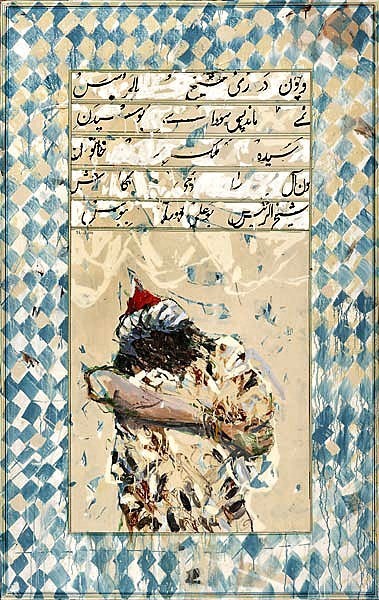Lucerne,
Arealstrasse 6 CH-6020 Emmenbrücke-Lucerne
17 October 2010 - 13 November 2010
Joy of Life as a Counter Vision
The latest works by the Iranian artist Shahriar Ahmadi translate their current theme into his customary powerful images and, in doing so, display a growing tendency towards the figurative.
In a maze of abstraction his characteristic, precisely composed, yet lively brush strokes create distinct outlines and literally come straight to the point.
One minute flashing images of unambiguous body shapes capture our attention, then scenes of great intimacy in which couples are drawn towards each other and the attraction between them becomes palpable to the viewer. Shahriar Ahmadi calls it the alchemy of love making, which he brings straight to canvas under the title “The Face of Things”.
He is not interested in a superficial romance à la Romeo & Juliet bur rather the profound relationship between eroticism and spiritual encounter that leads to a higher level of ecstasy. With Adam and Eve as protagonists in one of his works, reference is made to their intercourse as the first of mankind.
His current preoccupation with this subject is due to the fact that Shahriar Ahmadi frequently works on themes that are directly opposed to the present situation. The widely held view of his fellow countrymen that one does not live in the here and now but in the past and future plays an important role in his work.
It is his way of presenting a positive counter-vision to the socio-politically conservative climate in Iran, which represses private persons and the arts alike: By portraying the culmination of the joy of life – love making – he illustrates the will to live in its most primal manifestation, thereby affirming a universal source of significance.
With great delicacy and subtlety – bordering on censorship – Shahriar Ahmadi refers obliquely to his stories without being explicit. The wonderful Persian saying “I show you the door so you know it has a window” cuts right to the chase of the matter: making a detour via analogy – a tried and tested tactic in the face of the country’s constantly restricted freedom of speech. Despite, or perhaps precisely because of the political situation, the rich literary tradition of his culture remains an important source of Shahriar Ahmadi’s work.He incorporates as pictorial themes and textual frameworks scenes from literary works, the permissiveness of which would go far beyond the scope of the rigid moral code of contemporary Iran. This artistic statement brings the legacy of history into the present day in a manner that avoids banal critique. Instead, it lends expression to the values at stake in a fundamental way.
He is not interested in a superficial romance à la Romeo & Juliet bur rather the profound relationship between eroticism and spiritual encounter that leads to a higher level of ecstasy. With Adam and Eve as protagonists in one of his works, reference is made to their intercourse as the first of mankind.
His current preoccupation with this subject is due to the fact that Shahriar Ahmadi frequently works on themes that are directly opposed to the present situation. The widely held view of his fellow countrymen that one does not live in the here and now but in the past and future plays an important role in his work.
It is his way of presenting a positive counter-vision to the socio-politically conservative climate in Iran, which represses private persons and the arts alike: By portraying the culmination of the joy of life – love making – he illustrates the will to live in its most primal manifestation, thereby affirming a universal source of significance.
With great delicacy and subtlety – bordering on censorship – Shahriar Ahmadi refers obliquely to his stories without being explicit. The wonderful Persian saying “I show you the door so you know it has a window” cuts right to the chase of the matter: making a detour via analogy – a tried and tested tactic in the face of the country’s constantly restricted freedom of speech. Despite, or perhaps precisely because of the political situation, the rich literary tradition of his culture remains an important source of Shahriar Ahmadi’s work.He incorporates as pictorial themes and textual frameworks scenes from literary works, the permissiveness of which would go far beyond the scope of the rigid moral code of contemporary Iran. This artistic statement brings the legacy of history into the present day in a manner that avoids banal critique. Instead, it lends expression to the values at stake in a fundamental way.
